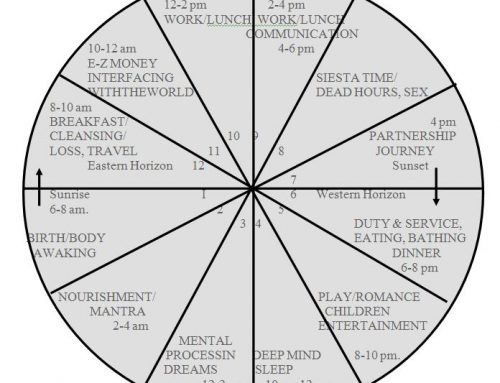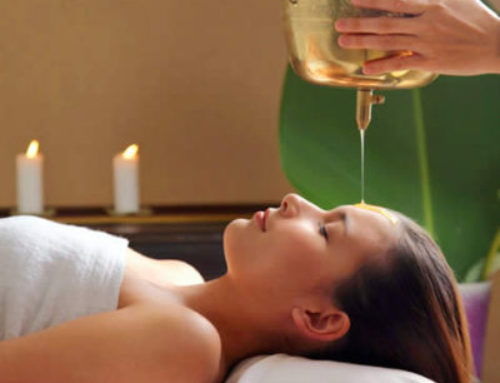Along with diet and lifestyle, Āyurveda recommends prāṇāyāma, or yogic breathing as a tool to kindle agni, balance your hormones, and burn mental āma. Mental āma is the residue of unprocessed thoughts and feelings in the brain. In Āyurveda, emotions and thoughts are material things; modern research seems to agree, showing that they ride on the molecules of our bodies and are affected by diet, lifestyle, and, yes, our breath.* Eastern medicine believes that where there is no life force, called prāṇa in Sanskrit or chi in Chinese, there is no life, and disease and pain are the result. Doing prāṇāyāma invites prāṇa to flow through the body freely. To preserve your mental and emotional wellbeing and prevent mental decline, begin a practice of yogic breathing today. It not only adds years to your life, but life to your years.
*See Molecules of Emotion: The Science behind Mind-Body Medicine by Candace Pert, Ph.D.
There are different forms of prāṇāyāma, the most essential of which will be described in this post For a full routine please refer to the excellent video by Dr. Vasant Lad, explaining the full complement of prāṇāyāma techniques as well as their healing benefits.
We have looked at ujjāyi prāṇāyāma in the post on exercise. Now I will introduce you to some common and not so common breathing exercises that will help you avoid alzheimers, improve your cholesterol profile, eliminate aches and pains and cure depression. In Balance Your Hormones, Balance Your Life, Dr. Claudia Welch credits yogic breathing for helping her clients when even diet and lifestyle couldn’t. Prāṇāyāma is one of the most powerful tools for self transformation because our breath is the bridge between the mind and body. Fifteen to thirty minutes of yogic breathing every day can save your life and your relationships.
Prāṇa āyāma literally means ‘breath extension’ and contains within its fold dozens of exercises, some held secret for thousands of years, and others more common. The simplest is diaphragmatic breathing. This entails taking air into the lower lobes of the lungs where sixty percent of oxygen receptors live. Lower lobe diaphragmatic breathing produces a calm, fat-burning state by activating the parasympathetic nervous system. By contrast, shallow upper lung breathing turns on the sympathetic nervous system and the stress response. This has been written about elsewhere, and I will not go into detail about the benefits: just do it!
*Refer to these excellent books for information on stress, how to avoid it, and why: Why Zebras Don’t Get Ulcers- written by a scientist for laypersons, a thorough review of the science of stress. Balance Your Hormones, Balance Your Life– The modern woman’s guide to alternate ways of balancing your hormones. Body, Mind, & Sport– The modern athlete’s bible for using the breath to guide your workout. Full explanation of parasympathetic and sympathetic breathing and what it’s good for.
Exercise A
Sit up straight or lie on your back. Place your hands on your belly and take a few deep breaths. As you breathe, feel the air going down to your belly button, pushing your hands out. Practice this for a few minutes. When belly breathing has become easy and comfortable, try putting your hands on the side of your ribcage, low by your kidneys. Now, try pushing your lower ribcage out using your breath as you inhale. You should feel your hands move a little bit- not as much as on your belly. Practice filling your lungs this way in addition to deep belly breathing- it will activate your deep, calm center, which is not only great for physical rejuvenation, but for peace of mind as well. Practice this until it becomes second nature, and you’re breathing this way all day long. When you’ve got the hang of deep belly breathing, move to the next prāṇāyāma- alternate nostril.
Exercise B
“Doing alternate-nostril breathing for 15 minutes a day can eliminate menopausal symptoms when nothing else can. Its calming effect on the nervous system and balancing effect on the hormones is quick and, usually, its only side effect is greater mental and emotional equilibrium.”- Change Your Hormones, Change Your Life, Claudia Welch
Alternate nostril breathing is perhaps the simplest and most effective technique you can do for physical, mental, and emotional health. Using the visualizations recommended below can also turn this prāṇāyāma into instant meditation.
The yogic secret of meditation is that you don’t have to try to empty your mind- let your practice do it for you. One of the reasons beginners drop out of meditation is because just sitting can be painful and boring. But starting with a light physical warm up, like yoga, dance, or t’ai chi, to open your channels, then proceeding to prāṇāyāma can help you slip into meditation much easier than just trying to sit. The alternate nostril techniques described here will help you fall into the gap of pure awareness with hardly any effort or boredom.
Here’s how it’s done. Make the viṣṇu mudrā with your hand, as pictured. Holding your right nostril closed with your thumb, inhale from the left nostril. Try picturing a sea of tiny blue shining particles moving with the air, vibrant, alive, and full of consciousness. This is visualizing light as a particle; you can also inhale pure light as a wave of shimmering consciousness. In either case, as you breathe in, let this cosmic prāṇa (chi- vital energy) merge with your third eye. Pause for a second (holding both nostrils shut using your thumb and ring finger), and let it swirl in your skull, doing what it needs to do – cleanse, build, or recycle old thoughts and emotions.
Then, keeping your left nostril closed, release your thumb from the right. Let the air out of your right nostril and with it all negative or used up mental processes. You can picture some of the prāṇa particles releasing from the top of your head as well, moving up and out at the same time as your nostril breath moves down, contributing to the cosmic consciousness. This helps to build higher awareness and makes this practice a bridge between physical, emotional, and spiritual healing.
Repeat this inhaling from the right nostril. Do not force it. Ideally, you should not be able to hear yourself inhale or exhale. Be as quiet as you can. Prāṇa is subtle and it rides on the air like a beach ball on the surface of a river. It is independent of the river- focus on the ball, not the water- the prāṇa, not the breath. You can pump oxygen into a dead body but that will not bring it to life. Prāna is not oxygen- it is cosmic consciousness. Learning to work with it means becoming as silent as possible.
In the beginning, focus on making the exhale quiet, while keeping the inhale normal or even forceful. Let the outward breath flow gently out without a sound- like a turtle breathing. When this becomes easy, try it the other way, making your inhale quiet. Experiment and let your body tell you what is right for you. Never force the breath to the point where you feel light-headed, irritable, or uncomfortable. Your face should be completely relaxed- no tension in any of its muscles. Try a light smile as you do this- it helps.
Practice for at least five and up to twenty five minutes every day. Over the next few chapters, you will learn more breathing techniques. Doing the Shiny, Happy Skull breath before Alternate nostril is a wonderful way to nourish and cleanse your brain of mental āma and reset your hormones every day. Combined with the other recommendations in these posts, you should be well on your way to mastering the dharma of your body!






